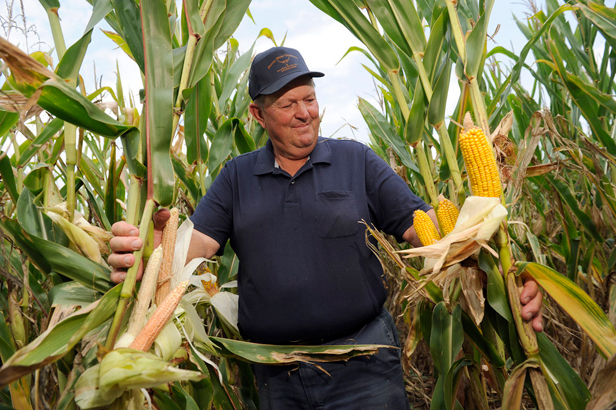Drought Puts Modified Corn Seed to the Test

Illinois farmer Mike Cyrulik didn’t foresee this year’s drought when, this spring, he planted 20 bags of a new corn seed on a slice of his 5,000-acre farm. Today, weeks before the harvest, much of his and his neighbors’ crop is dead or dying. But not the portion of his land where he planted the new seed. The healthy looking plants have “wound up being the talk of the town,” says Cyrulik, who expects a significantly higher yield, by 30 to 50 bushels, from each of those 220 acres in Bloomington.
The reason is drought-resistant corn, produced by one of the world’s largest seed companies, Syngenta, which began limited sales just before the 2011 growing season. In fact, three major seed producers—Syngenta, along with DuPont and Monsanto—are hoping for successes similar to Cyrulik’s in the midst of the worst drought to strike the U.S. in half a century.
The devastating dry spell comes as Syngenta and DuPont’s Pioneer company are ramping up marketing of a new generation of corn seeds bred so that farmers can improve their harvest from water-stressed crops. In Monsanto’s case, the company has been conducting premarket field tests of the first of any commercial crop to contain a genetically engineered drought-tolerant trait.
Drought tolerance is one of the most challenging areas of research in agriculture, says Monsanto drought and water utilization lead Mark Edge. In recent years, technologies that allow more rapid screening for promising raw genetic material have helped advance both traditional breeding and genetic modification programs in this area.
Biotech crops have been on the market since the 1990s, but traits such as pest and herbicide resistance are easier to engineer because they involve single genes. How efficiently a plant uses water, and how well it does under water stress, are more complicated responses controlled by many sets of genes and parts of a plant. Environmental factors, such as the timing of drought onset, also matter.
For these reasons, researchers say, it’s as yet unclear whether conventional breeding or genetic engineering, or some combination of the two, will be most effective in improving drought tolerance in a wide variety of crops.
Part of the difficulty in engineering for drought tolerance is that researchers must find genes that have a large enough effect on a plant’s response to warrant a major commercialization investment, says Purdue University agronomist Mitch Tuinstra. The average transgenic crop can take Monsanto more than a decade and $100 million to bring to market.
“It’s going to be one of the key mechanisms moving forward, but I don’t think we’re going to find the magic bullet that solves all of our problems,” he says. Technology can’t change the fact that a plant needs water, he says.
Approved by U.S. regulators in December, Monsanto’s drought-resistant corn contains a gene from a common soil bacteria that allows the corn to take up water more slowly. Before it is sold next year, the biotech corn is being field-tested in states like Kansas and Nebraska that often experience moderate droughts. By also using prescribed farming practices, the farmers are seeing good results so far, says Edge, but then again, expectations aren’t dramatic—in the range of single-digit percentage yield improvements.
In the research pipeline, there is more to come. Corn has been an early focus, but Monsanto is in the early development phase for a drought-tolerant genetically modified cotton. DuPont and Syngenta eventually plan to introduce their own genetically engineered corn for dry areas.
Despite the Syngenta corn’s success on his farm, Cyrulik cannot yet answer the initial question—how the product would perform for him in an average rainfall year—that spurred him to try it out in the first place. He thinks it could be useful to pay the premium for seeds that can provide a safety net for drought, but they’d still have to produce up to his usual standards when normal rains come.
That dilemma—when and how much Corn Belt farmers should invest in planning for dry years—is one likely to be more common if climate change leads to more extreme or unpredictable drought. Are the new drought-tolerant corns the answer? “I don’t know. I’m not ready to bet the farm on it,” he says.
Keep Reading
Most Popular
Large language models can do jaw-dropping things. But nobody knows exactly why.
And that's a problem. Figuring it out is one of the biggest scientific puzzles of our time and a crucial step towards controlling more powerful future models.
The problem with plug-in hybrids? Their drivers.
Plug-in hybrids are often sold as a transition to EVs, but new data from Europe shows we’re still underestimating the emissions they produce.
Google DeepMind’s new generative model makes Super Mario–like games from scratch
Genie learns how to control games by watching hours and hours of video. It could help train next-gen robots too.
How scientists traced a mysterious covid case back to six toilets
When wastewater surveillance turns into a hunt for a single infected individual, the ethics get tricky.
Stay connected
Get the latest updates from
MIT Technology Review
Discover special offers, top stories, upcoming events, and more.